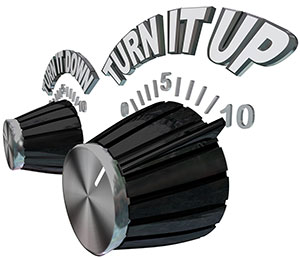 “Compression” is an audio treatment or “effect” that is often hard to explain to someone new to audio recording. Actually, the basic idea of compression isn’t very hard at all; it’s just too often poorly explained, like a LOT of audio recording concepts. I’ve given it a shot a couple of times here on Home Brew Audio – see Improve Or Ruin Your Audio With an Effect Called Compression, Should You Use Compression In Audio Recording? and Vocal Compression Using Reaper’s ReaComp Effect Plugin. Those last two have videos to help explain compression.
“Compression” is an audio treatment or “effect” that is often hard to explain to someone new to audio recording. Actually, the basic idea of compression isn’t very hard at all; it’s just too often poorly explained, like a LOT of audio recording concepts. I’ve given it a shot a couple of times here on Home Brew Audio – see Improve Or Ruin Your Audio With an Effect Called Compression, Should You Use Compression In Audio Recording? and Vocal Compression Using Reaper’s ReaComp Effect Plugin. Those last two have videos to help explain compression.
One important thing that I think gets left out of a lot of explanations is that compression turns the audio volume down, but only PARTS of an audio file. Only the audio that is loud enough that the volume crosses a line (determined by you) will get turned down; all the rest of the audio remains as it is.
Then, once only the loudest sections of the audio have been turned down, you can (but only if you want to!) turn ALL of the audio up a bit louder than you could have before compression. I think this concept is much better shown than explained in words, and I do just that in the video at the Should You Use Compression In Audio Recording? article, which I mentioned above.
Anyway, the reason I started this post was to tell you about a series of posts and videos explaining compression that is being done by the folks at Sonic Sense. The first post is here: www.sonicsense.com/blog/reviews-and-tutorials/how-to-use-a-compressor-audio-compression-explained, and the video that accompanies it is below. Enjoy!
compression
Getting The Vocal To Blend Well In The Mix
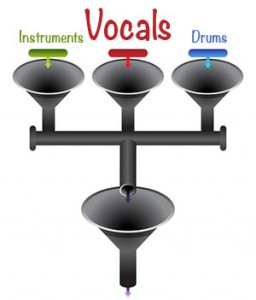 A friend sent me a private message on Facebook asking me about a recording problem he was having. He had recorded the music for a song, and that sounded great. Then he went ahead and recorded the vocal track, and that, by itself, sounded pretty decent too. However, he reported that the vocal was too up front in the mix. It didn’t blend in with the music, so they didn’t sound like a cohesive performance. He asked me if I had any ideas for getting the vocal to blend in better with the music. It turns out that I do:-P. Below is the advice I gave him:
A friend sent me a private message on Facebook asking me about a recording problem he was having. He had recorded the music for a song, and that sounded great. Then he went ahead and recorded the vocal track, and that, by itself, sounded pretty decent too. However, he reported that the vocal was too up front in the mix. It didn’t blend in with the music, so they didn’t sound like a cohesive performance. He asked me if I had any ideas for getting the vocal to blend in better with the music. It turns out that I do:-P. Below is the advice I gave him:
My Reply
Hi Ric! Yes, I do have a couple of ideas for you to try. The standard answer is to add reverb. You don’t have to add much to make it seem a bit further back in the mix. In fact sometimes you can get the “pushing further back” effect with so little reverb that you can’t really hear the verb in the mix. If you solo the vocal, you can hear it, but when all tracks are playing, the effect is simply to make the vocal seem a bit further away.
However, as with anything, the best way is a bit more involved, doing several things, but doing them in small doses, so that it’s the combination of several small things that create one subtle but significant effect (I’m always amazed at how similar cooking is to mixing). So here are some things to add to the act of applying just a pinch of reverb.
- Obviously, you can just turn the volume down on the vocal track. But then you might have trouble hearing the softest words/phrases.
- In that case, add a compression effect to the vocal track to even out the dynamics.
- Also, “ducking” is an awesome way to get the vocal to sink more into the mix. Here is an article I wrote about ducking: https://www.homebrewaudio.com/what-is-ducking-in-audio-recording/
- Then to fine-tune things, I recommend listening to the mix in the car and on an iPod/iPhone through headphones. Check for notes that pop out a little too loud or that are maybe too soft to hear, and make notes. Printing a lyric sheet and taking that with you to make these notes is highly recommended (yeah, I do this a lot:)). When you have all the notes, go back to your software and put a volume envelope on the vocal track. you can use that to quickly raise or lower just certain syllables or short words.
If you do just a smidgen of ALL of those things, you’ll probably be quite happy with the result.
Good luck!
Using Compression To Punch Up The Kick and Snare Drums
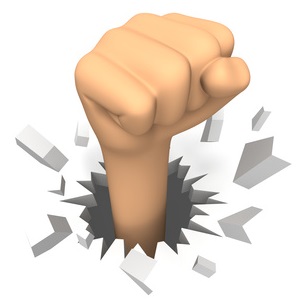 Compression is an effect often used to add punch and power to kick and snare drums, especially in pop and rock music. Adding compression to the drums in your recordings is a simple matter nowadays (yes, I’m still all geeky about how much easier it is to do recording now that everything is software – even 15+ years since I was able to make the transition from analog tape).
Compression is an effect often used to add punch and power to kick and snare drums, especially in pop and rock music. Adding compression to the drums in your recordings is a simple matter nowadays (yes, I’m still all geeky about how much easier it is to do recording now that everything is software – even 15+ years since I was able to make the transition from analog tape).
Anyway, the process of adding the compressor effect (now usually a plugin on the tracks in your software) is the same with pretty much all recording software. Below is an article showing you how to do it using Cakewalk’s SONAR X2 Producer software. I did a video showing you how to add compression in Reaper using the built-in compressor plug-in, “ReaComp” in my post, Vocal Compression Using Reaper’s ReaComp Effect Plugin.
Read the article on drum percussion in Sonar here: http://blog.cakewalk.com/make-kick-and-snare-sound-more-aggressive/
Compression: What Needs It And What Doesn't?
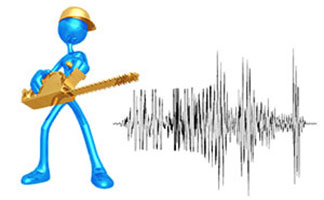 I’ve talked about compression quite a lot because it is an excellent, useful, and very powerful tool in your audio recording arsenal. But like anything powerful, you can also use too much.
I’ve talked about compression quite a lot because it is an excellent, useful, and very powerful tool in your audio recording arsenal. But like anything powerful, you can also use too much.
For a review of what compression is, see these Home Brew Audio Articles:
Vocal Compression Using Reaper’s ReaComp Effect Plugin
Improve Or Ruin Your Audio With an Effect Called Compression, and
Should You Use Compression In Audio Recording?
Those will give you the basics of what compression is. The last one has a white-board video of me explaining the concept.
You can see all the articles on the site that mention compression by going to our “Compression” tag page here: https://www.homebrewaudio.com/tag/compression/
Important! Only use compression (or any audio effect, for that matter( if you know WHY you’re using, and can tell whether it did what you wanted after you apply it. You’d be surprised how many people use compression “because they think they should,” and not with any particular objective in mind. OK, moving on…
Like with most tools, you don’t always want to compress every sound source in your recording. The main job of a compressor is to even out audio levels or loudness. So if you have something that has some loud parts and some really quiet parts, it probably could benefit from some compression so that the person listening to it doesn’t have to turn it up when it’s too quiet, and then turn it down again when it’s too loud. Compression does that for you. That’s its job.
The human voice is pretty dynamic, meaning we express ourselves with our voices with a large variety of loud and very soft sounds. So a pretty good rule of thumb is that a lead vocal in a song will almost always benefit from at least some compression. Acoustic guitar can also be quite variable in volume and is also usually a good candidate for compression. Likewise with drums (especially the audio from drum overhead mics, which capture the entire kit).
But other things may rarely need compression. I’d say that electronic keyboards and their software synthesizer cousins are rarely in need of much, if any compression. Electric guitar often does not NEED compression, per se. But there are other results – sort of like side-effects – that you can use compression for, like adding punch or sustain to enhance the way something sounds. Electric guitar is often the recipient of such treatment. For example, if you are familiar with the electric guitar sound of the group, Boston, you have heard super-compressed electric guitar.
At the end of the day, though, you need to be the judge of what should be compressed and what shouldn’t when it comes to your mixes. Oh yeah, I forgot to mention final mixes. Those almost always benefit from some compression as well. Anyway, as I was saying, you should use your own ears and judgement on using compression.
And when you DO use it, be careful! Too much compression (using extreme settings) can cause unpleasant artifacts (a fancy way of saying unwanted sounds) like unnatural “pumping” where the audio attack and release cause the audio to sound even more uneven than before (ironically). Another thing that is common with vocal over-compression is excess sibilance, where all the “S’s” started sounding way too hot. So avoid hissing and pumping vocals by using compression responsibly;).
If you have any other examples of when and when not to use compression, please leave a comment below. We’d love to hear from you.
Cheers!
Ken
My New Vocal Compression Technique
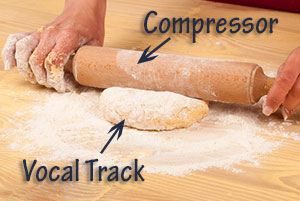 For years I’ve been following the common and age-old advice for vocal compression, which is to start at about a 3:1 ratio, using a fast attack time (like 0-to-10 millseconds so little-to-none of the vocal is heard above the threshold), and medium slow release time (50-to-80 milliseconds so the notes decay naturally). Then set the threshold to -20 dB. You’ll then need to adjust the threshold setting until only the loudest notes are being reduced, and that reduction should not be much more than about 3 dB. Then just use your ears to make adjustments until you get things just right. To review what the heck I’m talking about with all these settings, see my video post Vocal Compression Using Reaper’s ReaComp Effect .
For years I’ve been following the common and age-old advice for vocal compression, which is to start at about a 3:1 ratio, using a fast attack time (like 0-to-10 millseconds so little-to-none of the vocal is heard above the threshold), and medium slow release time (50-to-80 milliseconds so the notes decay naturally). Then set the threshold to -20 dB. You’ll then need to adjust the threshold setting until only the loudest notes are being reduced, and that reduction should not be much more than about 3 dB. Then just use your ears to make adjustments until you get things just right. To review what the heck I’m talking about with all these settings, see my video post Vocal Compression Using Reaper’s ReaComp Effect .
But as with all things audio, you should use your ears to determine what is “right.” Still though, it’s hard to stray too far from what you’ve been taught is the “normal” way of doing things. I just re-watched a video (see my post An Interesting Vocal Compression Tip) that I wrote about here a few months ago that suggests a bit of a different approach to vocal compression. At the time, I sort of thought it was interesting and suggested you might want to try it out. However, I did not take my own advice! Now I have, though. And I have a new normal.
In the video, Andrew Koss explains his technique of using super fast attack AND release times (like zero on both), with a very low ratio (try 1.5:1 or 2:1), and gain reduction of -10 or -12 dB. I tried it and really like the way it makes my vocals sound.
One thing to be careful of, though, is sibilance (that enhanced SSSSSS sound) being hyped, which can happen on some compressors (or compressor plugins) when extreme settings are selected. If you REALLY like the added pop in the voice that this technique gives you, and you get a bit of excess sibilance, you can always use EQ to reduce it. See our article – How to Fix SSS-Sibilance in Your Audio With Sound Editing Software.
Try it and see what you think!
Cheers,
Ken